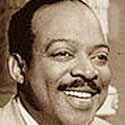"I was always willing to say, 'Let's see what happens,' when something came up that looked like it might help me get a little closer to where I wanted to be." ~ Count Basie
Jazz pianist and blues man William James Basie (1904-1984), who nicknamed himself "Count," was born on this day in Red Bank, New Jersey. His mom played the piano, his dad the horn. Young William grew up with music in his heart.
With guitarist Freddie Green, bass player Walter Page, and drummer Jo Jones, Count Basie created a powerful piano style with the 1930s "swing" era of jazz.
"Of course, there are a lot of ways you can treat the blues, but it will still be the blues," he said. His was one of Kansas City's most influential bands for over 45 years.
A genius at music technique, Basie had a gift for setting tempos for both large orchestras and small combos. He used leads and cues to keep the melody moving smoothly, then the music could speed up or downshift as necessary. His lean, spare piano style was clean and inspired. He set the pace. His music flowed.
His band loved to play. Musicians from other bands would join in the jams.
Basie explained his playing technique, "When I come in for a solo, I do it unexpectedly, using a strong rhythm background behind me. That way, we figure the Count's piano isn't going to become monotonous."
Monotonous? As if.
With such classics as April in Paris and One O'clock Jump (1937), the "Jump King" worked with Billie Holiday, Frank Sinatra, Tony Bennett, Quincy Jones and others-- creating buoyant, joyous swing.
The Count's version of Fly Me to the Moon featuring Sinatra's vocal was the first song played on the moon by Apollo 10 astronauts.
"It's the way you play that makes it," he said. "Play like you play. Play like you think, and then you got it, if you're going to get it. And whatever you get, that's you, so that's your story."

